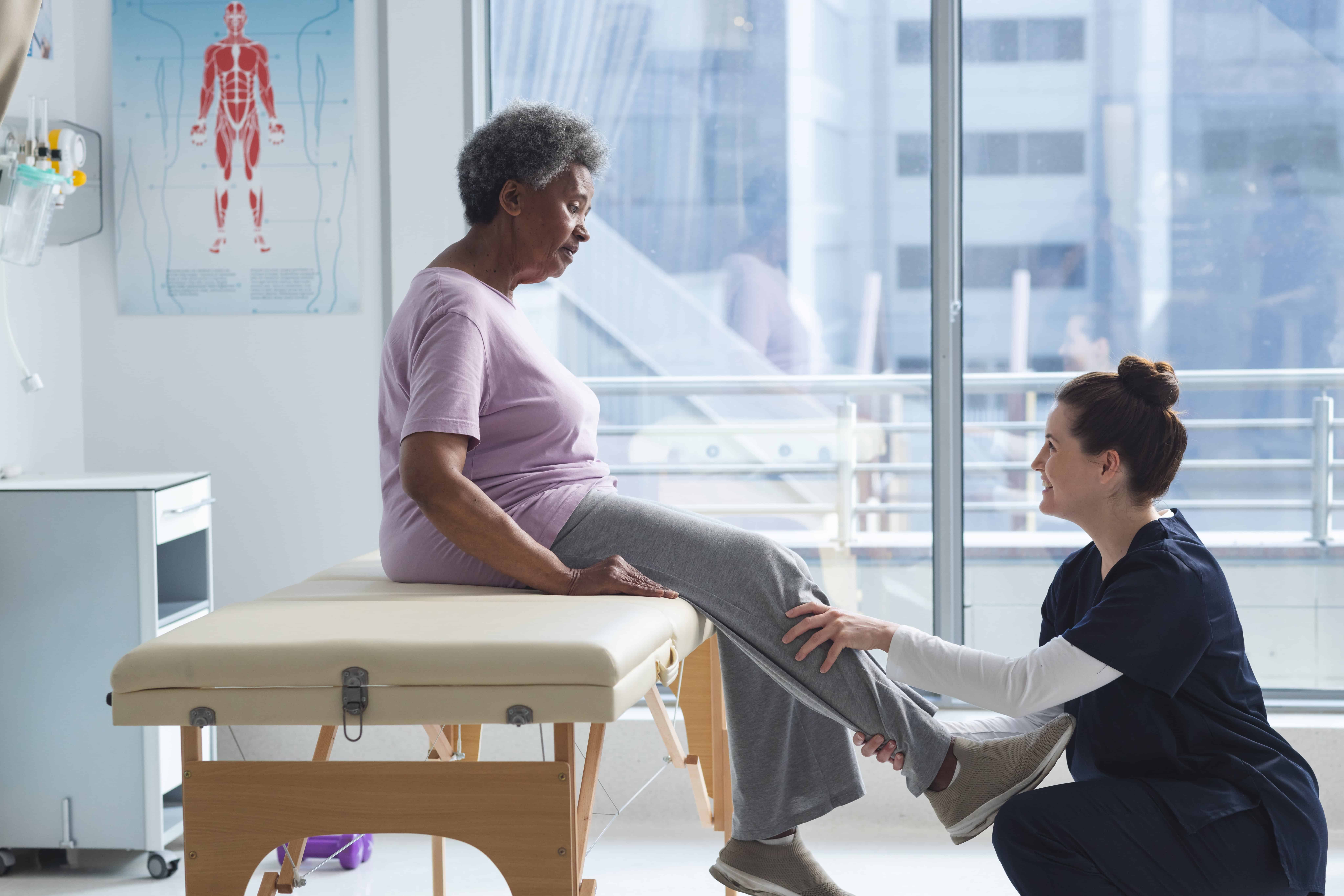A diagnosis of osteoarthritis (OA) for joint pain can be a great cause of distress. Many people believe that if you have arthritis, your pain can’t be reduced and will deteriorate until a joint replacement can be performed. The truth is much more complicated, largely due to our bodies’ incredible ability to adapt and change.
I’ve seen the worry in patients’ eyes when they first come in after receiving an osteoarthritis diagnosis, to understand how physiotherapy for osteoarthritis will help. They often think their diagnosis is the beginning of the end for their active lifestyle. But after more than 20 years of experience as a physio, I can tell you that’s not the case for most people.
With osteoarthritis, your joints, such as your knees, hips, and hands, are mostly affected. This could present in the form of morning stiffness when you just wake up, or the nagging pain when you are standing for long, or even difficulty in gripping things, which was once child’s play. These symptoms can be truly frustrating, but the real problem is when you do not understand what’s happening or know how to manage them.
The Real Story About Osteoarthritis Management
The pain and disability associated with arthritis can be improved with the implementation of a closely targeted physiotherapy for osteoarthritis exercise program by a physiotherapist. In some cases, the pain attributed to arthritis can actually be due to an entirely different treatable cause, while in other cases, providing the joint with extra support by strengthening the muscles around the joint can have a significant effect.
Let me share something from my experience – about half the patients who come to our clinic with “arthritis pain” actually have issues that aren’t directly related to their arthritis at all! Sometimes it’s muscle tension, sometimes it’s a movement pattern that’s gone wrong, and sometimes it’s simply weakness from avoiding activity because of pain.
How Your Movement Patterns Make All the Difference
The way we move is often affected negatively by pain and this in itself can create changes to biomechanics that can further contribute to pain. In many cases, it is believed that surgery is the best choice for treatment and can have incredible results. However, there is a strong recommendation for physiotherapy as a first line of treatment to build your strength and improve loading by learning better movement patterns. Even if you do choose to go ahead with surgical intervention, seeing a physiotherapist beforehand can provide better outcomes – it becomes your prehabilitation.
I often tell my patients that pain is like having a thorn in your shoe. At first, you limp a little to avoid the discomfort. After a while, that limping becomes your new normal way of walking, even when you switch to shoes after a while – Your body has learned an unhelpful pattern.
This is exactly what happens with arthritis. Your knee hurts, so you start putting more weight on your “good” side. Before long, your hip on the painful side starts working differently, your back compensates, and suddenly you’ve got a whole chain of issues that actually make your original problem worse.
In our clinic, we take videos of patients walking before and after even just one session of movement retraining. The difference can be remarkable, and patients often say, “I had no idea I was walking like that!” By making these corrections, I am not curing arthritis, but my aim is to dramatically reduce the strain on the affected joints. Treating the whole body as one, rather than focusing on one painful joint, can be a key to successful rehab—for example, recommending a right insole for the foot or a brace for the knee results in offloading or supporting a joint, reducing pain, and creating room for better movement acts like a cherry on top.
What Real Treatment Looks Like
Physiotherapists are highly skilled at identifying exactly what is causing you pain and can help you reach the highest level of function. While exercise is a very powerful treatment, it’s not a one-size-fits-all approach; you need an exercise program based on your specific needs.
‘Just exercise more’ is often what people advise. That’s like telling someone with a broken arm to “just use it more.” The wrong exercise can make things worse! I remember one patient who had been faithfully doing squats she found on YouTube, not realizing they were increasing the compression on her arthritic knee joints.
Instead, a good physiotherapy program for osteoarthritis typically includes:
Hands-on treatment to loosen tight tissues and improve joint movement. This might feel like a gentle massage, stretching, or joint mobilizations—all aimed at giving you more comfortable movement.
Strength training that doesn’t hurt on the scale of 1-10, 1-2/10 pain is OK, and it should not linger on for more than 24-48 hours! We start where you’re comfortable and gradually build up. For knee OA, we might begin with simple seated leg extensions before progressing to standing exercises. The goal is to build strength without increasing pain.
Hydrotherapy is highly recommended for those who find land exercises too painful initially. The buoyancy of water makes movement easier while still providing resistance for strengthening. Many of my patients start in water and gradually transition to land-based exercise as they build confidence and strength.
Balance work because, let’s face it, we all get a bit wobbly as we age, and arthritis can make that worse. Better balance and coordination mean better loading, fewer falls, and more confidence in your daily activities.
Real-world strategies for managing your condition day-to-day. This includes modifying ways to do your daily tasks so as to reduce joint strain or simply learning how to pace your activities.
I remember working with one of my patients with hip osteoarthritis who loved gardening but couldn’t kneel or squat anymore. We mixed our rehab with pacing activities and finding some garden tools to let him continue his passion without the pain, and gradually increasing the time spent in that activity. Sometimes the simplest solutions make the biggest difference to quality of life.
Your Unique Treatment Journey
There is no one model fit for all in physiotherapy. It is designing your personalized treatment plan starting with a full assessment session, starting with identifying your weak muscles, understanding your limitations, finding trigger points and restoring movement of those stiff joints.
At Procure Physio, we conduct an OA-focused GLAD program for our patients who are keen on managing their pain and are committed to getting their mobility back. It is a 6-week exercise-based program that begins with an initial assessment.
Your treatment needs to be as individual as you are. During your first visit, our physios spend time understanding not just your pain, but your life as a whole– what activities matter most to you, what are your current challenges, and what your health goals are.
It’s Not Just About Exercise
Your physiotherapist can also identify any external factors that may be contributing to your pain. Such as unsupportive footwear, workplace set up etc. Talk to us to see how we can help you manage your osteoarthritis.
Sometimes the smallest change can make a huge difference. I had a patient with hand arthritis who was struggling to work at her computer. We made minor adjustments to her keyboard position and mouse type, and recommended a simple paraffin wax treatment before work. Her pain levels dropped dramatically within a week.
For those with knee arthritis, proper footwear can be a game-changer. I remember one patient who switched from flat fashion shoes to supportive walking shoes with proper arch support, and her knee pain decreased by about half, almost immediately. These “environmental factors” might seem minor, but they can have a major impact on your symptoms.
The Psychological Side of Pain Management
Living with arthritic pain affects more than just your joints—it impacts your overall lifestyle. The sleep patterns get affected, and frustration creeps up as you have to give up on the activities that you love; one feels limited with the constant pain.
Part of our approach at Procure Physio involves helping you understand pain better. When you realize that pain doesn’t always mean “damage”—that” sometimes it’s your body’s overly cautious alarm system—it changes how you respond to it. This understanding alone can reduce fear and help you move more confidently.
When Should You Start?
Earlier the better. Do not wait to reach a stage where pain is limiting your basic movements. Keep a conscious check on your body, observe for any changes that you spot in joint function and pain. Like most cases, prevention is always better than a cure. Similar is the scenario for Osteoarthritis.
Even if you’ve had arthritis for years, it’s never too late to improve your function with our exercise-based rehab.
The Bottom Line
Unfortunately, there is no magic cure for osteoarthritis; it is best to manage it through a targeted physiotherapy approach. Physiotherapy for osteoarthritis can significantly help reduce pain and improve body function.
Don’t let your joint pain and stiffness limit you. See a physio at Procure Physio, where we will work together to get you moving freely again. Our holistic approach of educating you during the treatment sessions not only builds your confidence but also helps you make better decisions for your day-to-day tasks and leads a happy, active life. It’s about regaining control over your movement.
Give us a call today to book your assessment, or understand more about our GLAD Program and take the first step toward better management of your osteoarthritis.

